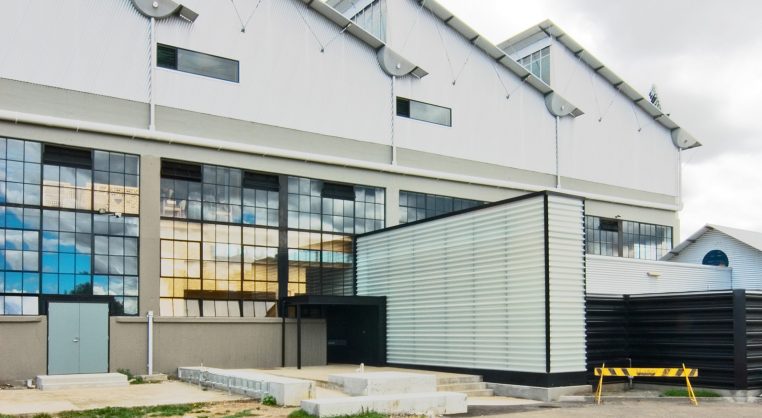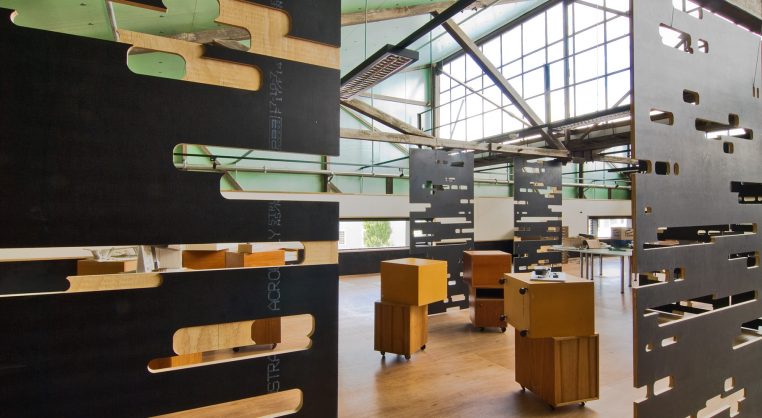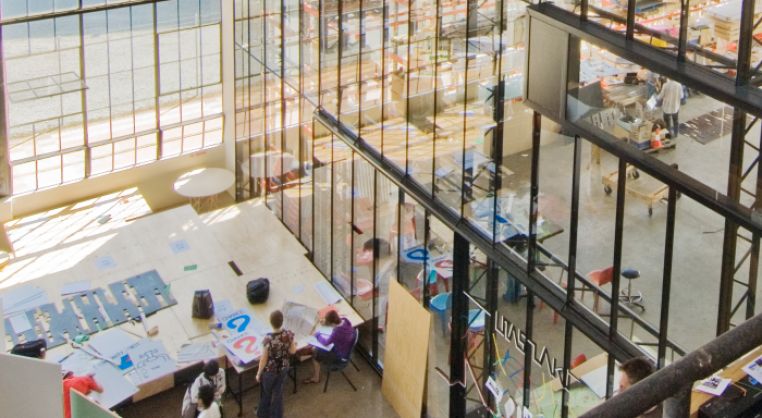The University of Tasmania’s School of Architecture and Design is housed in a 1950s diesel workshop at the Inveresk Railyards in Launceston. The adaptive reuse maintains and responds to the industrial aspects of the building while pursuing an integrated environmentally sustainable design (ESD) approach that exemplifies the school’s environmental focus, timber research program and ‘learning by making’ philosophy.
The new facility includes adaptable studio spaces that also host exhibitions, a multimedia Learning Hub, seminar spaces, timber workshops, staff offices and a lecture theatre that is accessible from the public foyer after hours.
The Inveresk Railyards is a heritage precinct adjacent to the Launceston CBD, which is now home to a range of cultural, hospitality and educational facilities in reused railway buildings. The same architectural team has subsequently designed a new workshop for the School of Fine Furniture, adjacent to the case-study building.
Download a printable version of the School of Architecture and Design case study (PDF 335 KB).
Site history and heritage
The Inveresk Railway Workshops was established in 1868 to service steam locomotives. Tasmania’s rolling stock was manufactured and maintained on site until 1994. It is significant for its demonstration of the development of railway policy, engineering and operations over 125 years. The railyards also played an important part in WWII munitions production.
The Diesel Workshop was built in 1950 when diesel power replaced steam. It was refurbished in 1995 as an exhibition building for the annual Launceston Show.
When the current adaptive reuse project began the building was clean and had been decontaminated and reroofed. All equipment had been removed except the overhead cranes. Vandalism meant that most of the windows were covered over with corrugated iron.
The workshop is on the Tasmanian Heritage Register as part of the Launceston Railway Station Complex.
Opportunities
The twelve-metre-high, single volume of the Diesel Workshop offered a large, robust, lightfilled space with some remnant machinery.
Challenges
External work was restricted by the presence of contaminated fill, while very deep foundations required piling of all new major structures.
The existing columns had limited structural capacity, which meant that new floors inserted into the building had to be lightweight timber structures. The budget was tight ($6M for 4,500 square metres).
Approach and outcome
The adaptive reuse was framed by three principal concerns – working with the industrial nature of the building and precinct, representing the school’s workshop teaching approach, and fully integrating ESD principles and expressing these as ‘loose fit’ solutions to the school’s needs.
The expansive volume of workshop is maintained by grouping the new enclosed spaces in a three-story block along the building’s eastern edge. Large flexible studios spaces and the workshop are located in the western and upper areas. This grouping of new facilities also reduced servicing requirements.
The sawtooth roof, steel-framed glazing, concrete structure, timber trusses, steel roof and gantry cranes are all retained. Particular care was taken to retain the outline of the southern facade as seen from the north-south Traverser engine alley, while also expressing the new school entry.
The new work continues the industrial architectural language, while being clearly contemporary in its detailing and materiality – structure is revealed and materials are used in their ‘natural’ forms with minimal applied finishes. New work is designed to be removable.
Environmental strategies are lowtech and continue the stripped back, legible approach.
The project is a good exemplar for the students of architecture and design working within it.
Lessons
- Careful planning and considered location of new enclosed spaces means that the dramatic, large-scale volume was retained.
- The new work is clearly distinct, and continues the robust industrial aesthetic in a contemporary manner.
- Close collaboration between the architectural practices and the school ensured an integrated ESD process, including substantially reduced power and water use. The result is successful environmental design on a modest budget.
Project team
Architect: Six Degrees Architects and Sustainable Built Environments (SBE), architects in collaboration. Builder: Vos Construction. Project manager: Colin Burston. Services: Engineering Solutions. Building surveyor: Protek Consulting. Structural engineer: George E Apted & Assoc. Quantity Surveyor: Simon Wragg & Assoc. ESD: Sustainable Built Environment. Conservation Management Plan: Michael Pearson, Heritage Management Consultants.
References
Tracey Avery “UTas School of Architecture”, Artichoke 19, 112–119.
Ceridwen Owen, “UTAS Architecture” Architecture Australia vol. 96, no. 4 (July/August, 2007), 76–85.
Ceridwen Owen and Roger Fay, “Conversion of a Heritage Listed Industrial Building – UTAS School of Architecture and Design” Environment Design Guide (August 2008).
Stephen Ward, “Breathing Life into the Corpse: Upcycling through adaptive reuse” in Designing for Zero Waste: Consumption, technologies and the built environment, ed Steffen Lehman and Robert Crocker (London: Earthscan, 2012).




